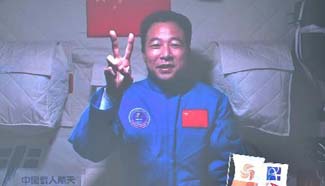SAN FRANCISCO, Nov. 1 (Xinhua) -- Researchers have used the electricity generated by high-efficiency solar cells to turn water into a chemical capable of storing 30 percent of the sun's energy over long periods of time, beating the prior record of 24.4 percent.
Developed by an interdisciplinary team at Stanford University, the most efficient means yet of storing electricity captured from sunlight in the form of chemical bonds is a step toward tapping solar energy's potential to provide abundant power, alternative to more polluting energy sources now in use.
Making solar power a viable alternative requires solutions to two key issues: storing the energy for use at all hours, and making the technology more cost effective.
The basic science behind the Stanford team's approach is using the electricity captured from sunlight to split water molecules into hydrogen and oxygen gas, and later recovering the stored energy either by recombining the hydrogen and oxygen into water to release electricity again, or by burning the hydrogen gas in an internal combustion engine. Although the process is well understood, the challenge has been turning this science into an efficient industrial process.
The starting point of the Stanford team's system, described in Nature Communications, is the solar cell they used in their experiments, one that is very different than the typical rooftop solar arrays. While typical rooftop arrays are based on silicon, the team employed solar cells pioneered by the lab of James Harris, a professor of electrical engineering, that use three less-common semiconductor materials. They are called triple-junction solar cells because each material is tuned to capture blue, green or red light, respectively.
The precision, triple-junction solar cells convert 39 percent of incoming solar energy into electricity, compared with roughly 20 percent for silicon-based, single-junction solar cells found on rooftops worldwide.
To store electricity captured from sunlight, Thomas Jaramillo, an associate professor of chemical engineering and of photon science, and his collaborators built on research they have been conducting on how to improve the performance of catalysts - materials that speed up chemical reactions but are not consumed in the process. The team looked in particular at water-splitting catalysts, in which electrons flow through the catalytic materials to break apart the stable H2O molecule.
Much of the catalytic process in the Stanford experiment is built on their previous advances in the area, with one particularly important approach to achieve their record energy capture, according to a news release from Stanford, in northern California on the U.S. west coast. Most photovoltaic-powered water-splitting reactions use a single electrolysis device, but the team was able to combine two identical electrolysis devices in such a manner to produce twice as much hydrogen, making use of their higher-efficiency solar cells and putting them to work.
"Tuning all the elements, electronics and the chemistry was critical," Harris was quoted as saying. "The entire system has to be perfectly balanced or the process wouldn't work at all."
Noting that the triple-junction solar cells and catalysts they used, which included platinum, are fine for proof-of-principle experiments, the team acknowledged that they are not for an industrial process. "Now we have to find ways to get similar results with less expensive materials and devices," Jaramillo said.










